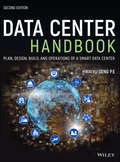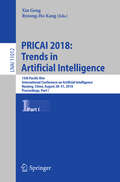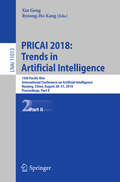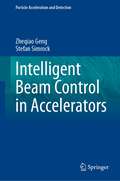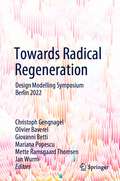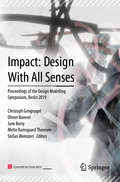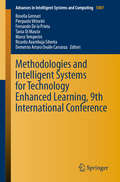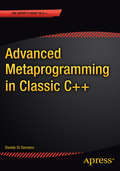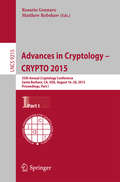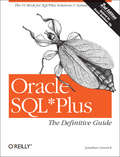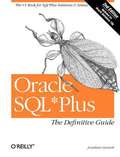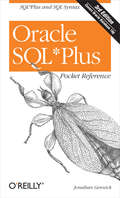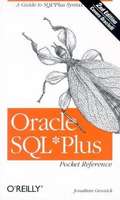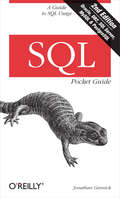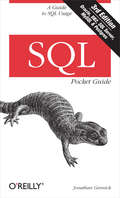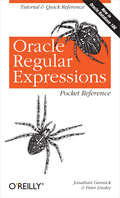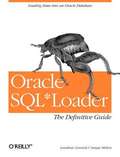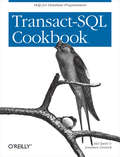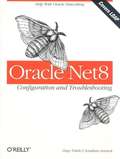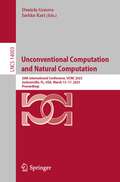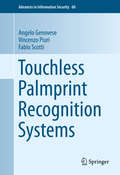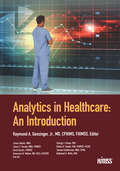- Table View
- List View
Data Center Handbook: Plan, Design, Build, and Operations of a Smart Data Center
by Hwaiyu GengDATA CENTER HANDBOOK Written by 59 experts and reviewed by a seasoned technical advisory board, the Data Center Handbook is a thoroughly revised, one-stop resource that clearly explains the fundamentals, advanced technologies, and best practices used in planning, designing, building and operating a mission-critical, energy-efficient, sustainable data center. This handbook, in its second edition, covers anatomy, ecosystem and taxonomy of data centers that enable the Internet of Things and artificial intelligent ecosystems and encompass the following:SECTION 1: DATA CENTER OVERVIEW AND STRATEGIC PLANNINGMegatrends, the IoT, artificial intelligence, 5G network, cloud and edge computingStrategic planning forces, location plan, and capacity planning Green design & construction guidelines and best practicesEnergy demand, conservation, and sustainability strategiesData center financial analysis & risk managementSECTION 2: DATA CENTER TECHNOLOGIESSoftware-defined environmentComputing, storage, network resource managementWireless sensor networks in data centersASHRAE data center guidelinesData center telecommunication cabling, BICSI and TIA 942Rack-level and server-level coolingCorrosion and contamination controlEnergy saving technologies and server designMicrogrid and data centersSECTION 3: DATA CENTER DESIGN & CONSTRUCTIONData center site selectionArchitecture design: rack floor plan and facility layoutMechanical design and cooling technologiesElectrical design and UPSFire protectionStructural designReliability engineeringComputational fluid dynamicsProject managementSECTION 4: DATA CENTER OPERATIONS TECHNOLOGIESBenchmarking metrics and assessmentData center infrastructure managementData center air managementDisaster recovery and business continuity managementThe Data Center Handbook: Plan, Design, Build, and Operations of a Smart Data Center belongs on the bookshelves of any professionals who work in, with, or around a data center.
PRICAI 2018: 15th Pacific Rim International Conference on Artificial Intelligence, Nanjing, China, August 28–31, 2018, Proceedings, Part I (Lecture Notes in Computer Science #11012)
by Xin Geng Byeong-Ho KangThis two-volume set, LNAI 11012 and 11013, constitutes the thoroughly refereed proceedings of the 15th Pacific Rim Conference on Artificial Intelligence, PRICAI 2018, held in Nanjing, China, in August 2018.The 82 full papers and 58 short papers presented in these volumes were carefully reviewed and selected from 382 submissions. PRICAI covers a wide range of topics such as AI theories, technologies and their applications in the areas of social and economic importance for countries in the Pacific Rim.
PRICAI 2018: 15th Pacific Rim International Conference on Artificial Intelligence, Nanjing, China, August 28–31, 2018, Proceedings, Part II (Lecture Notes in Computer Science #11013)
by Xin Geng Byeong-Ho KangThis two-volume set, LNAI 11012 and 11013, constitutes the thoroughly refereed proceedings of the 15th Pacific Rim Conference on Artificial Intelligence, PRICAI 2018, held in Nanjing, China, in August 2018.The 82 full papers and 58 short papers presented in these volumes were carefully reviewed and selected from 382 submissions. PRICAI covers a wide range of topics such as AI theories, technologies and their applications in the areas of social and economic importance for countries in the Pacific Rim.
Intelligent Beam Control in Accelerators (Particle Acceleration and Detection)
by Zheqiao Geng Stefan SimrockThis book systematically discusses the algorithms and principles for achieving stable and optimal beam (or products of the beam) parameters in particle accelerators. A four-layer beam control strategy is introduced to structure the subsystems related to beam controls, such as beam device control, beam feedback, and beam optimization. This book focuses on the global control and optimization layers. As a basis of global control, the beam feedback system regulates the beam parameters against disturbances and stabilizes them around the setpoints. The global optimization algorithms, such as the robust conjugate direction search algorithm, genetic algorithm, and particle swarm optimization algorithm, are at the top layer, determining the feedback setpoints for optimal beam qualities.In addition, the authors also introduce the applications of machine learning for beam controls. Selected machine learning algorithms, such as supervised learning based on artificial neural networks and Gaussian processes, and reinforcement learning, are discussed. They are applied to configure feedback loops, accelerate global optimizations, and directly synthesize optimal controllers. Authors also demonstrate the effectiveness of these algorithms using either simulation or tests at the SwissFEL. With this book, the readers gain systematic knowledge of intelligent beam controls and learn the layered architecture guiding the design of practical beam control systems.
Towards Radical Regeneration: Design Modelling Symposium Berlin 2022
by Christoph Gengnagel Olivier Baverel Giovanni Betti Mariana Popescu Mette Ramsgaard Thomsen Jan WurmThis book reflects and expands on the current trends in the Architecture Engineering and Construction (AEC) industries to respond to the unfolding climate and biodiversity crisis. Shifting away from the traditional focus, narrowly centered on efficiency, the book presents a variety of approaches to move the AEC community from an approach that presents new challenges in all areas of the industry, from a linear, extractive paradigm to circular and regenerative one. The book presents contributions including research papers and case studies, providing a comprehensive overview of the field as well as perspectives from related disciplines, such as computer science, biology and material science. The chapter authors were invited speakers at the 8th Design Modelling Symposium “Towards Radical Regeneration”, which took place at the University of the Arts in Berlin in September 2022.
Impact: Proceedings of the Design Modelling Symposium, Berlin 2019
by Christoph Gengnagel Jane Burry Mette Ramsgaard Thomsen Stefan Weinzierl Olivier BaverelThis book reflects and expands on the current trend in the building industry to understand, simulate and ultimately design buildings by taking into consideration the interlinked elements and forces that act on them. Shifting away from the traditional focus, which was exclusively on building tasks, this approach presents new challenges in all areas of the industry, from material and structural to the urban scale. The book presents contributions including research papers and case studies, providing a comprehensive overview of the field as well as perspectives from related disciplines, such as computer science. The chapter authors were invited speakers at the 7th Symposium “Impact: Design With All Senses”, which took place at the University of the Arts in Berlin in September 2019.
Final Cut Pro Portable Genius
by GeniusdvThis savvy Portable Guide shows you how to get the most from Final Cut Pro. You'll find cool and useful tips, full-color screenshots, and pages of easy-to-access shortcuts and tools that show you which editing technique is right for you, how to use Final Cut Pro as a sound and mixing tool, and the best ways to maximize the output of your final product.
Methodologies and Intelligent Systems for Technology Enhanced Learning, 9th International Conference (Advances in Intelligent Systems and Computing #1007)
by Rosella Gennari Pierpaolo Vittorini Fernando De la Prieta Tania Di Mascio Marco Temperini Ricardo Azambuja Silveira Demetrio Arturo Ovalle CarranzaThis book, which gathers the outcomes of the 9th International Conference on Methodologies and Intelligent Systems for Technology Enhanced Learning and its related workshops, expands on the topics of the evidence-based TEL workshop series in order to provide an open forum for discussing intelligent systems for TEL, their roots in novel learning theories, empirical methodologies for their design and evaluation, stand-alone solutions, and web-based ones. The Conference was hosted by the University of Salamanca and was held in Ávila (Spain) from the 26th to the 28th of June 2019. Its goal was to bring together researchers and developers from industry, education, and the academic world to report on the latest scientific research, technical advances, and methodologies. We wish to thank the sponsors: IEEE Systems Man and Cybernetics Society, Spain Section Chapter and the IEEE Spain Section (Technical Co-Sponsor), IBM, Indra, Viewnext, Global Exchange, AEPIA, APPIA and AIR institute.
Advanced Metaprogramming in Classic C++
by Davide Di GennaroTake a detailed and intense look into template metaprogramming (TMP) using classic C++. Tackle language aspects, design patterns, examples and applications, with special emphasis on small reusable techniques that will improve the quality of daily work. Advanced Metaprogramming in Classic C++: Third Edition is a book to sit with and learn from. Users of its prior editions point out that they come back to it over and over. This edition enhances the readability and clarity of the discussion. The two newer standards are not used in the code so that the examples can be rich, illustrate the point, and be run with confidence. The code can be readily adapted to include the elements of the Modern C++ standards. The gain for the reader is that TMP is presented in the book as a set of techniques that will enable a new style to your C++ coding while making it exceptionally clear and efficient. The approach in the book is used to maximize compatibility and clearly illustrate the techniques, enabling the reader to comprehend difficult material without the burdens of compiler errors, and other unnecessary complexities and enabling a much more intense treatment of the subject. For those interested in Modern C++, all subsequent additions to the C++ language are fully compatible with the code in this book and users familiar with them can leverage the techniques introduced in C++XX to make the patterns in this book even more powerful. There is a chapter that discusses issues regarding the two newer standards and the basics needed to program for the newer standards are readily available online. What makes the book exceptional is the level of understanding of the concepts involved imparted by the author. This is not just a rote overview of metaprogramming. You will truly understand difficult topics like static assertions, how to write metafunctions, overload resolution, lambda expressions, and many others. More than that, you will work through them with practical examples guided by the author's frank explanations. This book requires you to think and to learn and to understand the language so that you can program at a higher level. What you'll learn What templates and the small object toolkit are, and how to use them How to do overload resolution How to do metaprogramming with interfaces, algorithms, functors and refactoring How to work with code generators What is opaque type principle and how to use it How to work with debugging templates and more A chapter devoted to issues surrounding C++0x and C++14 Who this book is for This book is for experienced C++ programmers who want to learn more. Table of Contents Part I 1. Templates 2. Small Object Toolkit Part II 3. Static Programming 4. Overload Resolution 5. Interfaces 6. Algorithms 7. Code Generators 8. Functors 9. Opaque Type Principle Part III 10. Refactoring 11. Debugging Templates 12. C++0X 13. Appendix A: Exercises 14. Appendix B: Bibliography
Advances in Cryptology -- CRYPTO 2015: 35th Annual Cryptology Conference, Santa Barbara, CA, USA, August 16-20, 2015, Proceedings, Part I (Lecture Notes in Computer Science #9215)
by Rosario Gennaro Matthew RobshawThe two volume-set, LNCS 9215 and LNCS 9216, constitutes the refereed proceedings of the 35th Annual International Cryptology Conference, CRYPTO 2015, held in Santa Barbara, CA, USA, in August 2015. The 74 revised full papers presented were carefully reviewed and selected from 266 submissions. The papers are organized in the following topical sections: lattice-based cryptography; cryptanalytic insights; modes and constructions; multilinear maps and IO; pseudorandomness; block cipher cryptanalysis; integrity; assumptions; hash functions and stream cipher cryptanalysis; implementations; multiparty computation; zero-knowledge; theory; signatures; non-signaling and information-theoretic crypto; attribute-based encryption; new primitives; and fully homomorphic/functional encryption.
Oracle SQL*Plus: The Definitive Guide
by Jonathan GennickDespite its wide availability and usage, few developers and DBAs have mastered the true power of Oracle SQL*Plus. This bestselling book--now updated for Oracle 10g--is the only in-depth guide to this interactive query tool for writing SQL scripts. It's an essential resource for any Oracle user. The new second edition of Oracle SQLPlus: The Definitive Guide clearly describes how to perform, step-by-step, all of the tasks that Oracle developers and DBAs want to perform with SQLPlus--and maybe some you didn't realize you could perform. With Oracle SQLPlus: The Definitive Guide, you'll expertly: write and execute script files generate ad hoc reports extract data from the database query the data dictionary tables customize an SQLPlus environment and much more It also includes a handy quick reference to all of its syntax options and an often-requested chapter on SQL itself, along with a clear, concise, and complete introduction. This book is truly the definitive guide to SQLPlus. It's an indispensable resource for those who are new to SQLPlus, a task-oriented learning tool for those who are already using it, and an immediately useful quick reference for every user. If you want to leverage the full power and flexibility of this popular Oracle tool, you'll need this book.
Oracle SQL*Plus: The Definitive Guide, 2nd Edition
by Jonathan GennickDespite its wide availability and usage, few developers and DBAs have mastered the true power of Oracle SQL*Plus. This bestselling book--now updated for Oracle 10g--is the only in-depth guide to this interactive query tool for writing SQL scripts. It's an essential resource for any Oracle user. The new second edition of Oracle SQL*Plus: The Definitive Guide clearly describes how to perform, step-by-step, all of the tasks that Oracle developers and DBAs want to perform with SQL*Plus--and maybe some you didn't realize you could perform. With Oracle SQL*Plus: The Definitive Guide , you'll expertly: write and execute script files generate ad hoc reports extract data from the database query the data dictionary tables customize an SQL*Plus environment and much more It also includes a handy quick reference to all of its syntax options and an often-requested chapter on SQL itself, along with a clear, concise, and complete introduction. This book is truly the definitive guide to SQL*Plus. It's an indispensable resource for those who are new to SQL*Plus, a task-oriented learning tool for those who are already using it, and an immediately useful quick reference for every user. If you want to leverage the full power and flexibility of this popular Oracle tool, you'll need this book.
Oracle SQL*Plus Pocket Reference
by Jonathan GennickThis pocket reference provides quick reference information that will help you use SQL*Plus, Oracle's interactive query tool. It summarizes all of the SQL*Plus syntax, including the syntax for new Oracle8 i release 8.1.6 features. SQL*Plus is available at every Oracle site--from the largest data warehouse to the smallest single-user system--and it's a critical tool for virtually every Oracle user. Despite its wide use, few developers and DBAs know how powerful a tool SQL*Plus can be. This book boils down the most vital information from Gennick's best-selling book, Oracle SQL*Plus: The Definitive Guide , into an accessible summary. It concisely describes interacting with SQL*Plus, selecting data, formatting reports with SQL*Plus, and tuning SQL queries. It also contains quick references to the SQL*Plus commands and format elements. This book is an indispensable companion to O'Reilly bestselling book, Oracle SQL*Plus: The Definitive Guide , but it does not replace it; the larger book is truly the definitive guide, suitable for readers at all levels of expertise. The definitive guide describes the many tasks that SQL*Plus can perform, and provides a tutorial on many SQL*Plus topics. But this quick reference is an excellent, portable resource for readers who want a pocket-sized summary of SQL*Plus capabilities and a reminder of how to issue specific commands and formatting options for SQL*Plus. Table of Contents: Interacting with SQL*Plus Selecting Data Formatting Reports Tuning SQL SQL*Plus Format Elements SQL*Plus Command Reference
Oracle SQL*Plus Pocket Reference: A Guide to SQL*Plus Syntax (Pocket Reference (O'Reilly))
by Jonathan GennickThe Oracle SQLPlus Pocket Reference is a must-have for anyone working with Oracle databases, especially those looking to maximize the effectiveness of SQLPlus. As Oracle's long-standing interactive query tool, SQLPlus is available at every Oracle site, from the largest data warehouse to the smallest single-user system. Despite its wide use, however, SQLPlus is still often not completely understood or fully utilized.Database administrators and developers alike will therefore find the Oracle SQLPlus Pocket Reference to be extremely beneficial. In addition to summarizing all of the SQLPlus syntax and format options, including new Oracle Database 10g features, this handy, on-the-job guide specifically shows readers how to:Differentiate between SQL and SQLPlusInteract with SQLPlus from both the command line and the web browserSelect, insert, update, and delete dataFormat both text and HTML reports with SQLPlusSpecify SQLPlus commands and format elementsTune SQL queriesThe new third edition of this book has been updated for Oracle Database 10g to include information on both SQLPlus and SQL. New SQL information includes the SELECT statement's new MODEL clause, flashback queries, partition outer joins, and DBMS_XPLAN.With its quick-reference format and compact size, the Oracle SQLPlus Pocket Reference follows in the long line of successful "pocket references" offered by O'Reilly. It also serves as the ideal companion to O'Reilly's larger, more comprehensive book on SQLPlus, the bestselling Oracle SQLPlus: The Definitive Guide.Author Jonathan Gennick is an editor for O'Reilly specializing in database and programming titles, having amassed some 17 years of programming and database management experience.
Oracle SQL*Plus Pocket Reference, 2nd Edition
by Jonathan GennickThe new 2nd edition of our Oracle SQL*Plus Pocket Reference includes many new features for Oracle9 i (e.g., COALESCE function, searched CASE expressions, new table join syntax, partition operations, MERGE statement, and syntax changes in existing SQL*Plus statements such as ACCEPT, DESRIBE, HELP, and SET) It also adds sections on basic SQL (a much-requested feature): INSERT, DELETE, UPDATE, SELECT, and transaction management. The pocket reference size is especially appropriate for this particular subject, s
SQL Pocket Guide
by Jonathan GennickSQL is the language of databases. It's used to create and maintain database objects, place data into those objects, query the data, modify the data, and, finally, delete data that is no longer needed. Databases lie at the heart of many, if not most business applications. Chances are very good that if you're involved with software development, you're using SQL to some degree. And if you're using SQL, you should own a good reference or two. Now available in an updated second edition, our very popular SQL Pocket Guide is a major help to programmers, database administrators, and everyone who uses SQL in their day-to-day work. The SQL Pocket Guide is a concise reference to frequently used SQL statements and commonly used SQL functions. Not just an endless collection of syntax diagrams, this portable guide addresses the language's complexity head on and leads by example. The information in this edition has been updated to reflect the latest versions of the most commonly used SQL variants including:Oracle Database 10g, Release 2 (includingthe free Oracle Database 10g Express Edition (XE))Microsoft SQL Server 2005MySQL 5IBM DB2 8.2PostreSQL 8.1 database
SQL Pocket Guide: A Guide to SQL Usage (Pocket References Ser.)
by Jonathan GennickIf you're a programmer or database administrator who uses SQL in your day-to-day work, this popular pocket guide is the ideal on-the-job reference. You'll find many examples that address the language's complexity, along with key aspects of SQL used in IBM DB2 Release 9.7, MySQL 5.1, Oracle Database 11g Release 2, PostgreSQL 9.0, and Microsoft SQL Server 2008 Release 2. SQL Pocket Guide describes how these database systems implement SQL syntax for querying, managing transactions, and making changes to data. It also shows how the systems use SQL functions, regular expression syntax, and type conversion functions and formats. All example SQL statements in this book execute against a set of tables, with data that you can quickly download. The third edition covers important database changes, including: Oracle's support of the recursive WITH syntax, and addition of PIVOT and UNPIVOT operators Functions new to Oracle, such as LISTAGG, NTH_VALUE, and more PostgreSQL's support of recursive WITH and some window functions DB2 syntax and datatypes, some compatible with Oracle MySQL features such as the TIMESTAMP type and the TO_SECONDS function
SQL Pocket Guide, 2nd Edition
by Jonathan GennickSQL is the language of databases. It's used to create and maintain database objects, place data into those objects, query the data, modify the data, and, finally, delete data that is no longer needed. Databases lie at the heart of many, if not most business applications. Chances are very good that if you're involved with software development, you're using SQL to some degree. And if you're using SQL, you should own a good reference or two. Now available in an updated second edition, our very popular SQL Pocket Guide is a major help to programmers, database administrators, and everyone who uses SQL in their day-to-day work. The SQL Pocket Guide is a concise reference to frequently used SQL statements and commonly used SQL functions. Not just an endless collection of syntax diagrams, this portable guide addresses the language's complexity head on and leads by example. The information in this edition has been updated to reflect the latest versions of the most commonly used SQL variants including: * Oracle Database 10g, Release 2 (including the free Oracle Database 10g Express Edition (XE)) * Microsoft SQL Server 2005 * MySQL 5 * IBM DB2 8.2 * PostreSQL 8.1 database
Oracle Regular Expressions Pocket Reference
by Jonathan Gennick Peter LinsleySupport for regular expressions in SQL and PL/SQL is one of the most exciting features of Oracle Database 10G. Oracle has long supported the ANSI-standard LIKE predicate for rudimentary pattern matching, but regular expressions take pattern matching to a new level. They provide a powerful way to select data that matches a pattern, as well as to manipulate, rearrange, and change that data. This concise pocket guide is part tutorial and part quick-reference. It's suitable for those who have never used regular expressions before, as well as those who have experience with Perl and other languages supporting regular expressions. The book describes Oracle Database 10G's support for regular expressions, including globalization support and differences between Perl's syntax and the POSIX syntax supported by Oracle 10G. It also provides a comprehensive reference, including examples, to all supported regular expression operators, functions, and error messages. O'Reilly's Pocket References have become a favorite among developers and database administrators everywhere. By providing a wealth of important details in a concise, well-organized format, these handy books deliver just what you need to complete the task at hand. Whether you're using regular expressions for the first time or applying your skills from other languages to the latest version of Oracle, the Oracle Regular Expressions Pocket Reference is the book to have close by.
Oracle SQL*Loader: The Definitive Guide
by Jonathan Gennick Sanjay MishraDespite the wide availability and use of SQL*Loader, few Oracle DBAs and developers know how powerful it really is. This book describes all of SQL*Loader's functions, including how to construct the necessary control files, load different types of data, and get the best performance. It covers the newest SQL*Loader features--the loading of large object (LOB) columns and the new object types (nested tables, varying arrays, and object tables).
Transact-SQL Cookbook
by Jonathan Gennick Ales SpeticThis unique cookbook contains a wealth of solutions to problems that SQL programmers face all the time. The recipes inside range from how to perform simple tasks, like importing external data, to ways of handling issues that are more complicated, like set algebra. Authors Ales Spetic and Jonathan Gennick, two authorities with extensive database and SQL programming experience, include a discussion with each recipe to explain the logic and concepts underlying the solution. SQL (Structured Query Language) is the closest thing to a standard query language that currently exists, and Transact-SQL -- a full-featured programming language that dramatically extends the power of SQL -- is the procedural language of choice for both Microsoft SQL Server and Sybase SQL Server systems. The Transact-SQL Cookbook is designed so you can use the recipes directly, as a source of ideas, or as a way to learn a little more about SQL and what you can do with it. Topics covered include: Audit logging. In addition to recipes for implementing an audit log, this chapter also includes recipes for: improving performance where large log tables are involved; supporting multiple-languages; and simulating server push. Hierarchies. Recipes show you how to manipulate hierarchical data using Transact-SQL. Importing data. This chapter introduces concepts like normalization and recipes useful for working with imported data tables. Sets. Recipes demonstrate different operations, such as how to find common elements, summarize the data in a set, and find the element in a set that represents an extreme. Statistics. This chapter?s recipes show you how to effectively use SQL for common statistical operations from means and standard deviations to weighted moving averages. Temporal data. Recipes demonstrate how to construct queries against time-based data. Data Structures. This chapter shows how to manipulate data structures like stacks, queues, matrices, and arrays. With an abundance of recipes to help you get your job done more efficiently, the Transact-SQL Cookbook is sure to become an essential part of your library.
Oracle Net8 Configuration and Troubleshooting
by Jonathan Gennick Hugo ToledoDescribes everything DBAs need to know to install configure, tune, and troubleshoot Net8, Oracle's networking technology. It covers the Oracle Internet Directory (OID), Oracle Names; the Multi-Threaded Server (MTS); and the Oracle Connection Manager, as well as the Oracle networking utilities (lsnctl, namesctl, cmctl, tnsping, Net8 Assistant, Net8 Easy Config, and Net8 Configuration Assistant). In addition, it provides networking troubleshooting techniques, commonly encountered Net8 configuration problems,
Unconventional Computation and Natural Computation: 20th International Conference, UCNC 2023, Jacksonville, FL, USA, March 13–17, 2023, Proceedings (Lecture Notes in Computer Science #14003)
by Daniela Genova Jarkko KariThis book constitutes the proceedings of the 20th International Conference on Unconventional Computation and Natural Computation, UCNC 2023, held in Jacksonville, FL, USA, in March 13–17, 2023. The UCNC conference series covers fundamental research on computation beyond the standard Turing model, including computational models and methods inspired by nature, and the computational properties of natural processes.
Touchless Palmprint Recognition Systems
by Angelo Genovese Vincenzo Piuri Fabio ScottiThis book examines the context, motivation and current status of biometric systems based on the palmprint, with a specific focus on touchless and less-constrained systems. It covers new technologies in this rapidly evolving field and is one of the first comprehensive books on palmprint recognition systems. It discusses the research literature and the most relevant industrial applications of palmprint biometrics, including the low-cost solutions based on webcams. The steps of biometric recognition are described in detail, including acquisition setups, algorithms, and evaluation procedures. Constraints and limitations of current palmprint recognition systems are analyzed and discussed. The authors also introduce innovative methods for touchless and less-constrained palmprint recognition, with the aim to make palmprint biometrics easier to use in practical, daily-life applications, and overcome the typical constraints and limitations described. Touchless Palmprint Recognition Systems targets professionals and researchers working in biometrics, image processing and three-dimensional reconstruction. Advanced-level students studying biometrics and computer science will also find this material valuable as a secondary text book or reference.
Analytics in Healthcare: An Introduction (HIMSS Book Series)
by Raymond A. GensingerThe editors of the HIMSS Books' best-seller Health: From Smartphones to Smart Systems have returned to deliver an expansive survey of the initiatives, innovators, and technologies driving the patient-centered mobile healthcare revolution. mHealth Innovation: Best Practices from the Mobile Frontier explores the promise of mHealth as a balance between emerging technologies and process innovations leading to improved outcomes-with the ultimate aim of creating a patient-centered and consumer-driven healthcare ecosystem. Examining the rapidly changing mobile healthcare environment from myriad perspectives, the book includes a comprehensive survey of the current-state ecosystem-app development, interoperability, security, standards, organizational and governmental policy, innovation, next-generation solutions, and mBusiness-and 20 results-driven, world-spanning case studies covering behavior change, patient engagement, patient-provider decision making, mobile gaming, mobile prescription therapy, home monitoring, mobile-to-mobile online delivery, access to care, app certification and quality evaluations, mixed media campaigns, and much more.
